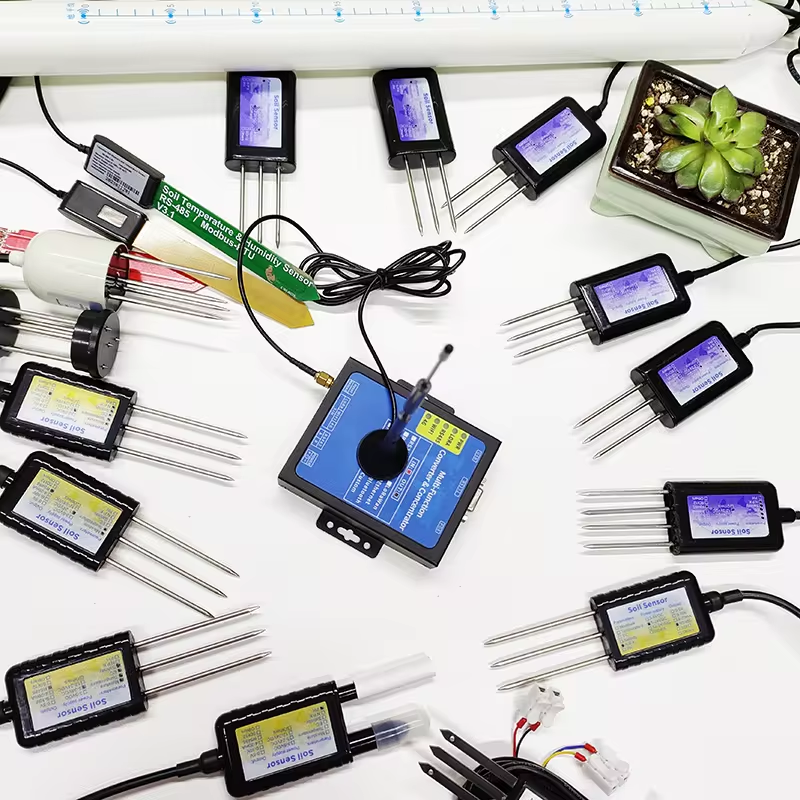As global climate change and population growth pose increasing challenges to agricultural production, farmers across India are actively adopting innovative technologies to improve crop yields and resource efficiency. Among them, the application of soil sensors is rapidly becoming an important part of agricultural modernization, and has achieved remarkable results. Here are some specific examples and data showing how soil sensors can be used in Indian agriculture.
Case one: Precision irrigation in Maharashtra
Background:
Maharashtra is one of India’s major agricultural states, but has faced severe water shortages in recent years. To improve the efficiency of water use, the local government has partnered with agricultural technology companies to promote the use of soil sensors in several villages.
Implementation:
In the pilot project, farmers installed soil moisture sensors in their fields. These sensors are able to monitor soil moisture in real time and transmit the data to the farmer’s smartphone. Based on the data provided by the sensors, farmers can precisely control the timing and volume of irrigation.
Effect:
Water conservation: With precision irrigation, water use has been reduced by about 40%. For example, on a 50-hectare farm, the monthly savings amount to about 2,000 cubic meters of water.
Improved crop yields: Crop yields have increased by about 18% thanks to more scientific irrigation. For example, the average yield of cotton increased from 1.8 to 2.1 tons per hectare.
Cost reductions: Farmers’ electricity bills for pumps have been reduced by about 30%, and irrigation costs per hectare have been reduced by about 20%.
Feedback from farmers:
“Before we were always worried about not irrigating enough or too much, now with these sensors we can precisely control the amount of water, crops grow better and our income has increased,” said one farmer involved in the project.
Case 2: Precision fertilization in Punjab
Background:
Punjab is India’s main food production base, but excessive fertilization has led to soil degradation and environmental pollution. To solve this problem, the local government has promoted the use of soil nutrient sensors.
Implementation:
Farmers have installed soil nutrient sensors in their fields that monitor the amount of nitrogen, phosphorus, potassium and other nutrients in the soil in real time. Based on the data provided by the sensors, farmers can accurately calculate the amount of fertilizer needed and apply precise fertilizer.
Effect:
Reduced fertilizer use: Fertilizer use has decreased by about 30 percent. For example, on a 100-hectare farm, the monthly savings in fertilizer costs amounted to about $5,000.
Improved crop yields: Crop yields have increased by about 15% thanks to more scientific fertilization. For example, the average yield of wheat increased from 4.5 to 5.2 tons per hectare.
Environmental improvement: The problem of soil and water pollution caused by excessive fertilization has been significantly improved, and soil quality has improved by about 10%.
Feedback from farmers:
“Before, we were always worried about not applying enough fertilizer, now with these sensors, we can precisely control the amount of fertilizer applied, the crops grow better, and our costs are lower,” said one farmer involved in the project.
Case 3: Climate Change response in Tamil Nadu
Background:
Tamil Nadu is one of the regions of India most affected by climate change, with frequent extreme weather events. To cope with extreme weather such as droughts and heavy rains, local farmers use soil sensors for real-time monitoring and rapid response.
Implementation:
Farmers have installed soil moisture and temperature sensors in their fields that monitor soil conditions in real time and transmit the data to farmers’ smartphones. Based on the data provided by the sensors, farmers can adjust irrigation and drainage measures in a timely manner.
Data summary
| State | Project content | Water resources conservation | Reduced fertilizer use | Increase in crop yield | Increase of farmers’ income |
| Maharashtra | Precision irrigation | 40% | - | 18% | 20% |
| Punjab | Precision fertilization | - | 30% | 15% | 15% |
| Tamil Nadu | Climate change response | 20% | - | 10% | 15% |
Effect:
Reduced crop losses: Crop losses were reduced by approximately 25 per cent as a result of timely adjustments to irrigation and drainage measures. For example, on a 200-hectare farm, crop losses after heavy rains were reduced from 10 percent to 7.5 percent.
Improved water management: Through real-time monitoring and rapid response, water resources are managed more scientifically, and irrigation efficiency has increased by about 20%.
Farmers’ income increased: Farmers’ income increased by about 15% due to reduced crop losses and higher yields.
Feedback from farmers:
“Before we were always worried about heavy rains or droughts, now with these sensors, we can adjust the measures in time, crop losses are reduced and our income is increased,” said one farmer involved in the project.
Future outlook
As technology continues to advance, soil sensors will become smarter and more efficient. Future sensors will be able to integrate more environmental data, such as air quality, rainfall, etc., to provide more comprehensive decision support for farmers. In addition, with the development of Internet of Things (IoT) technology, soil sensors will be able to interconnect with other agricultural equipment for more efficient agricultural management.
Speaking at a recent conference, India’s agriculture minister said: “The application of soil sensors is an important step in the modernization of Indian agriculture. We will continue to support the development of this technology and promote its wider application to achieve sustainable agricultural development.”
In conclusion, the application of soil sensors in India has achieved remarkable results, not only improving the efficiency of agricultural production, but also improving the living standards of farmers. As technology continues to advance and spread, soil sensors will play an increasingly important role in India’s agricultural modernization process.
For more weather station information,
please contact Honde Technology Co., LTD.
Email: info@hondetech.com
Company website: www.hondetechco.com
Post time: Jan-17-2025


